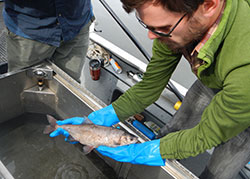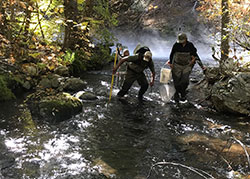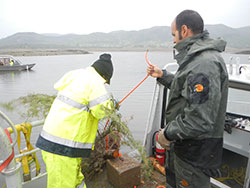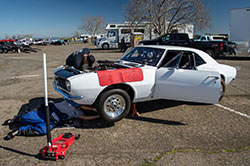Ben Ewing shows off a large White Catfish that turned up in an electrofishing survey of Clear Lake.

Recovering the rare and threatened Clear Lake Hitch has been a priority for Environmental Scientist Ben Ewing.

Backpack electrofishing Deer Creek in Nevada County 2018.

Recycled Christmas trees provide warmwater fish habitat at New Hogan Lake in Calaveras County.

Away from work, Ben Ewing's 1967 Chevy Camaro occupies much of his time and attention.
Ben Ewing is an environmental scientist for CDFW's North Central Region. Based out of the region headquarters office in Rancho Cordova, Sacramento County, Ben serves as the district fisheries biologist for Alpine, Amador, Calaveras and Lake counties.
Born and raised in Santa Barbara, Ben holds a Bachelor's degree in wildlife management from Humboldt State University. He first joined CDFW as a volunteer staffing a hunter-angler check station at Camp Roberts on the Central Coast and was later hired as a scientific aid in 2004. Ben worked as a scientific aid in three CDFW regions – the North Central Region, the Marine Region and the Central Region – before landing a permanent position with CDFW in 2007 as a reservoir fisheries biologist in Riverside County. He rejoined CDFW's North Central Region in his current capacity in 2012.
What does a typical day at work look like for you?
When I am out in the field, I may be doing a boat-based electrofishing survey, backpack electrofishing, frog surveys, snorkel surveys, public outreach, warmwater fish habitat work or gill net surveys. All these surveys are used to gather information on the specific fishery we are working on.
I spend most of my spring working with the Clear Lake hitch up in Lake County. It's a threatened species under the California Endangered Species Act. In the summer and fall, I am doing a lot of backcountry work in the Sierra Nevada mountains.
I get to spend a lot of time in beautiful country and simultaneously try to improve the recreational fishery as well as try and save listed species such as the Clear Lake hitch, Lahontan cutthroat trout, and Paiute cutthroat trout.
What are some of your biggest challenges?
One of the greatest challenges is trying to recover the Clear Lake hitch in order to de-list it under the California Endangered Species Act. Getting money for a minnow is a lot harder than for a salmonid. It only grows to about 11 or 12 inches as an adult. No one eats it, no one fishes for it, so it's pretty much at the bottom of the priority list.
But it's native to the Clear Lake watershed. It's an indicator species that speaks directly to the water quality problems at Clear Lake – agricultural runoff, water diversions, drought. If we can improve the health of the watershed and bring back the Clear Lake hitch, Clear Lake will benefit, the local economy will benefit, the whole community will benefit.
What's one thing you'd like the public to know about the fisheries or fishing in the counties you work in?
That CDFW's North Central Region – and, really, the entire state of California – has an unbelievable amount of diversity of fisheries. California has world class trout, bass, salmon and other ocean fishing all in one state. We have high mountain lakes, the ocean, the Delta, the rivers. Californians are very fortunate to have so many fishing options. Clear Lake was recently voted the No. 1 bass fishing lake in the entire nation by Bassmaster Magazine.
Speaking of Clear Lake, how much active fisheries management really goes on there?
We monitor it by electrofishing regularly every spring and try to get out there every fall as well. It is usually a collaboration between CDFW's Fisheries Branch and our North Central Region. I've put fish habitat into Clear Lake so shore anglers will have better access to the fish. During the drought, we received complaints from the bass tournament organizers that the average weight of the bass was going down. Fisheries Branch and Region staff then went out to gather weights of bass to compare them to data collected in previous surveys to see if there was a significant decrease in average weights. We believe the drought may have impacted not only the bass, but the rest of the fish species in Clear Lake. Clear Lake is shallow and it loses a lot of surface acres in a drought, which negatively impacts water quality, food resources, and fish habitat. The record drought from 2015-2017 really hit the fishery hard.
How has COVID-19 changed the way you do your job?
It has limited what type of field work I can do due to the proximity issues. I had to cancel my Clear Lake Hitch work halfway into the season this spring, which was a bummer. We also are limited to specific field surveys that don't put us into close proximity of others. I can still get out into the field, but I am much more limited. As of right now we aren't allowed to do any boat-based surveys or backpack electrofishing (due to COVID-19 and physical distancing requirements). Those activities are typically how I do my usual field sampling.
Is there a particular CDFW project you worked on that you're especially proud of?
I take a lot of pride in trying to recover the dwindling Clear Lake hitch. The fish was listed in 2014, and I think it would be a great success story for our region and the department to be able to remove this fish from listing. It would be the first inland fish species successfully removed from the list if we could pull it off.
I take a lot of pride in acquiring black bass for the display tank at the annual International Sportsmen's Expo in Sacramento every January. We electrofish the Delta just prior to the expo and then release the fish back into the Delta once the expo is over. Year in and year out, the department supplies the biggest bass on the ISE tour. It's great to show off these big, beautiful bass to the public and what they can find just down the road in the Delta. I also think the ISE show is a great way to interact with our constituents and the public and share my passion for the outdoors and fishing with them.
Away from work, where are we likely to find you?
At the drag strip racing my 1967 Chevy Camaro, fishing in the backcountry or out on my ski boat somewhere.
Tell us something else about yourself many people might be surprised to learn.
Prior to joining the department, I worked at an auto shop changing tires as well as working as a mobile carpet cleaner. Having those jobs motivated me to get a better education so that I would end up with a career that I love. I feel very fortunate to work for the department and have a job that I love.
CDFW Photos